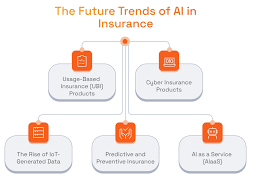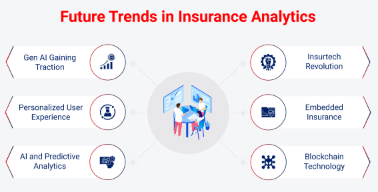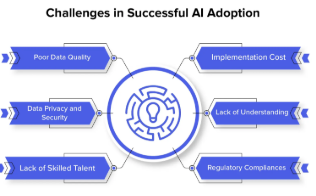The Rise of Insur Tech: How AI and Big Data Are Reshaping the Insurance Industry
 Lahari Pandiri
Lahari Pandiri
In recent years, the insurance industry has witnessed a transformation that is reshaping how companies operate and interact with customers. This change is largely driven by InsurTech—an umbrella term for innovations in the insurance sector brought about by technology, particularly artificial intelligence (AI) and big data. These advancements are not only improving operational efficiency but also enhancing customer experiences, making the industry more accessible, affordable, and personalized. This article explores how AI and big data are revolutionizing the insurance landscape and what the future of the industry holds.
The Traditional Insurance Model
Before delving into how AI and big data are changing the game, it’s important to understand the traditional insurance model. Traditionally, insurance companies relied heavily on manual processes and historical data to assess risk, price policies, and handle claims. These processes were often slow, opaque, and prone to human error. Moreover, the interaction between insurers and policyholders was largely impersonal, with customers typically dealing with complex paperwork and long wait times.
While the insurance industry has always been data-driven, it was often siloed, with limited ability to analyze large volumes of real-time data. Today, however, the convergence of AI and big data is transforming these outdated practices, enabling insurers to offer more accurate, efficient, and customer-friendly solutions.

How AI Is Impacting the Insurance Industry
AI technology is increasingly becoming a central component in the evolution of InsurTech. Machine learning algorithms, natural language processing, and predictive analytics are being used to automate routine tasks, enhance decision-making, and streamline the overall customer experience.
- Risk Assessment and Underwriting
Underwriting—the process of evaluating risk and determining the premium for insurance coverage—has historically been a tedious and subjective task. Traditional methods involved reviewing a client’s personal information, medical history, or driving record to assess risk, but these evaluations were often incomplete or inconsistent.
AI-driven systems can now analyze vast amounts of structured and unstructured data (such as social media activity, sensor data from connected devices, or even satellite images) to gain a more accurate understanding of an individual's or entity's risk profile. Machine learning models can identify patterns and predict risks with remarkable precision, allowing insurers to offer more personalized pricing models and even adjust premiums based on real-time behavior. For example, car insurers can now use telematics (data from a vehicle’s sensors) to assess driving behavior, and offer discounts to customers who demonstrate safe driving habits.
EQ 1:Risk Assessment (Premium Calculation) Using AI and Big Data:

- Claims Processing and Fraud Detection
Claims processing is another area where AI is making significant strides. Traditional claims management often involved a slow and cumbersome process, where human adjusters would manually assess damage, verify the claim, and determine compensation. This process could take days or even weeks, frustrating customers who expect quicker resolutions.
AI-powered tools have automated many aspects of the claims process. Image recognition software, for instance, can analyze photos of damages and compare them with previous claims to assess the extent of the damage accurately. Chatbots and virtual assistants are now able to guide policyholders through the claims process in real time, reducing the burden on human agents and speeding up the entire workflow.
Additionally, AI is playing a crucial role in fraud detection. By analyzing patterns in claims data, AI systems can detect suspicious activity that may otherwise go unnoticed by human assessors. This has made it easier for insurers to prevent fraudulent claims, saving millions of dollars each year.

- Customer Service and Engagement
The way insurance companies engage with their customers is also being transformed by AI. Chatbots and virtual assistants powered by AI are now being deployed by insurers to offer 24/7 support to customers. These systems can handle routine inquiries, assist in purchasing policies, provide quotes, and even help with filing claims, all without human intervention.
Furthermore, AI tools can predict customer needs and proactively offer relevant services or updates. For example, if an AI system detects that a customer’s car is due for an insurance renewal, it can send reminders or even offer an automatic renewal option. This level of personalized service helps build stronger relationships with customers and enhances their overall experience.
EQ 2: Claims Prediction and Fraud Detection Using Big Data and AI

Big Data: Unlocking New Insights and Opportunities
Big data—the enormous volumes of structured and unstructured data generated every second—plays a crucial role in transforming the insurance industry. In the past, insurance companies had access to limited data, mostly collected from policyholders and claims. However, today, they have access to a wealth of data from numerous sources, including social media, IoT devices, wearable technology, GPS systems, and more.
Big data allows insurers to gain deeper insights into customer behavior, preferences, and needs, enabling them to tailor policies more precisely. With the ability to process and analyze data in real-time, insurers can offer dynamic pricing models, where premiums are adjusted based on factors such as weather conditions, driving behavior, or even individual health metrics.
- Personalized Insurance Products
One of the most significant ways big data is reshaping insurance is by enabling the development of highly personalized insurance products. Rather than offering one-size-fits-all policies, insurers can now create customized plans based on specific customer profiles. For example, in health insurance, wearable devices that track physical activity can allow insurers to offer discounts to individuals who maintain healthy lifestyles. In auto insurance, data from connected vehicles can enable insurers to create usage-based policies where premiums are based on how much and how safely a person drives.
- Predictive Analytics
Predictive analytics, powered by big data, is another key area where insurers are benefitting. By leveraging vast amounts of data, insurers can predict future trends and anticipate risks. For example, predictive models can help insurers foresee emerging health conditions in policyholders or identify areas where natural disasters are likely to occur. This information allows insurers to better manage their risk exposure and prepare for future events, while also offering policyholders the opportunity to take preventative measures.
- Improved Customer Segmentation
Big data also enables insurers to segment their customer base more effectively. By analyzing various data points, insurers can identify specific customer needs and target them with tailored marketing campaigns. This not only improves customer acquisition rates but also ensures that customers are offered products that best meet their needs, which enhances satisfaction and retention.

The Future of InsurTech
As the insurance industry continues to embrace AI and big data, the future holds even more exciting possibilities. The continued advancement of technologies like blockchain, the Internet of Things (IoT), and autonomous vehicles will further enhance the capabilities of InsurTech, opening new avenues for growth and innovation.
In the coming years, we can expect even more seamless integration between insurers and customers, with AI taking on a more significant role in managing everything from claims to policy renewals. We may also see the rise of new business models, such as peer-to-peer insurance or on-demand insurance, which are made possible by advancements in technology.
In conclusion, the rise of InsurTech, powered by AI and big data, is revolutionizing the insurance industry in profound ways. These technologies are enabling insurers to offer more personalized, efficient, and transparent services, ultimately benefiting both the companies and their customers. As AI and big data continue to evolve, the future of insurance looks brighter, more dynamic, and more customer-centric than ever before.
Subscribe to my newsletter
Read articles from Lahari Pandiri directly inside your inbox. Subscribe to the newsletter, and don't miss out.
Written by
